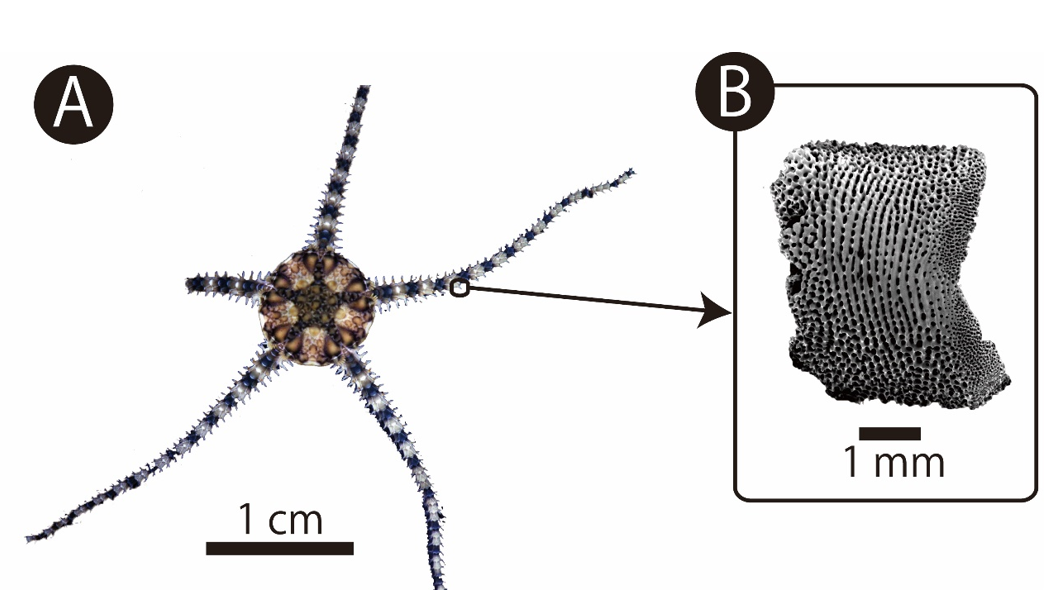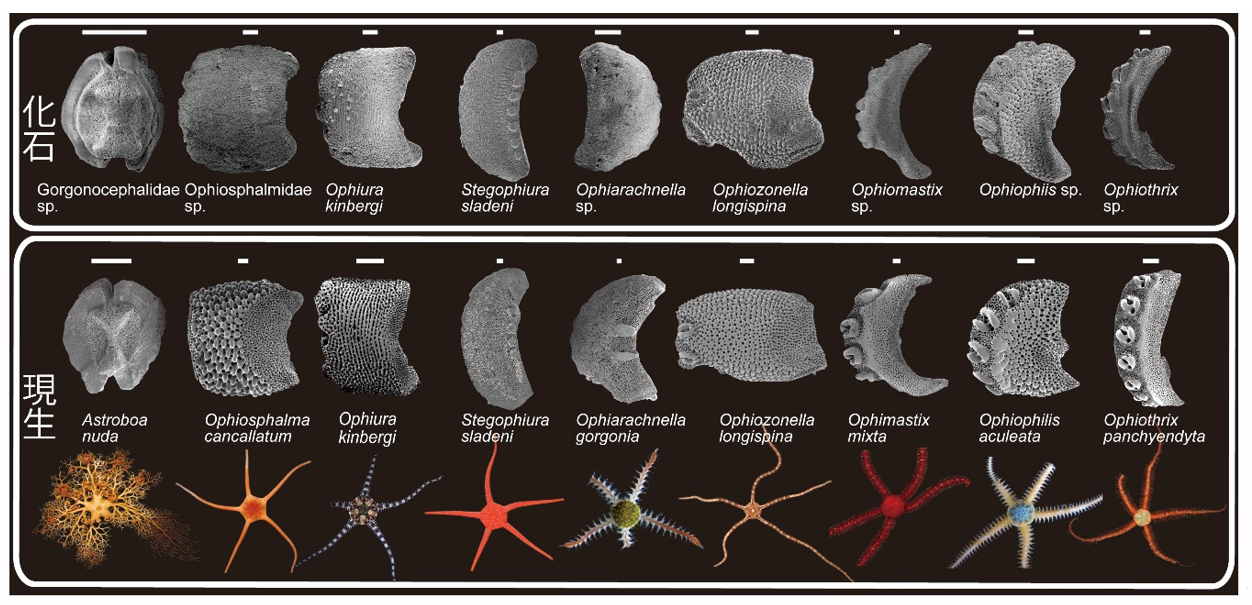DATE2021.12.21 #Press Releases
Nine Fossil Species Discovered at Once: Spider Starfish May Be a New Environmental Indicator Species
Disclaimer: machine translated by DeepL which may contain errors.
Masanori OKANISHI (Project Assistant Professor, Misaki Marine Biological Station)
Hisanori KOUZUKA (Technical Specialist Staff, Misaki Marine Biological Station)
Minoru Kaneko (Former high school teacher, Ota City, Gunma Prefecture)
Shota Mitsui (Technician, Marine Biology Institute of Japan, Inc.)
Key points of the presentation
- We identified the species from fossil bone fragments of a few millimeters in size that constitute the body of spider starfish, a member of the echinoderms (Note 1), and succeeded in clarifying the fossil spider starfish fauna (Note 2) in a single stratum for the first time in the Indo-Western Pacific region.
- Until now, there have been few records of fossil bone fragments in Japan, but nine species were obtained at once from the Late Pleistocene (Note 3) stratum (Yokosuka Formation) distributed in the Miura Peninsula, Kanagawa Prefecture.
- Although the fossil bone fragments of spider starfish have been overlooked so far, this study indicates that they may actually be microfossils (Note 4) with a large amount of burial and number of species, which can be the subject of research for new paleoenvironmental estimates.
Summary of Presentation
Fossils that are difficult to see with the naked eye are called microfossils and are used as useful materials to estimate the paleoenvironment. Foraminifera (Note 5 ), shell-shaped worms (Note 6), and diatoms (Note 7) are well known as representative examples.
A research group led by Project Assistant Professor Masanori Okanishi of The University of Tokyo Graduate School of Science has discovered fossil arm bone fragments of nine species of spider starfish, which are echinoderms, from the Otsu Sand and Mud Formation of the Yokosuka Formation (approximately 10,000 to 130,000 years ago) located on the Miura Peninsula, Kanagawa Prefecture. The body of arachnids is composed of several millimeters of calcium carbonate bone fragments, which are separated after death. In recent years, Project Assistant Professor Okanishi and his colleagues have discovered these bone fragment fossils in the Miyata Formation, another stratum on the Miura Peninsula, but only two reports have been published describing a single species. Therefore, this is the first time in the Indo-West Pacific region that the spider starfish fauna has been elucidated based on fossil bone fragments from a single stratum.
The paleoenvironmental estimation of the nine species found as fossils was based on comparison with the habitat (water depth) of spider starfish currently distributed in Sagami Bay, and it was inferred that the depositional environment of the Otsu Sand and Mud Formation was a continental shelf or shelf slope at a water depth of 80 m or greater. This result is generally consistent with the results of a previous study that estimated the paleoenvironment using fossil shells. We expect that the paleoenvironmental estimation using fossil bone fragments of spider starfish will be further developed in the future.
Contents of Presentation
Background of the study
Spider starfishes are marine invertebrates that live in a variety of environments, including under rocks, in mud and other sediments, and on top of other animals, depending on the species. Spider starfish are mostly a few centimeters to a dozen centimeters long, but the calcium carbonate bone fragments that make up their bodies tend to dissociate after death and burrow into the sediment, leaving behind fossil remains. In Europe and the United States, fossilized bone fragments are used for paleoenvironmental reconstructions as facies fossils. In Japan, however, although studies of whole body fossils of spider starfish are known, only two species of bone fragment fossils have been found in the Miyata Formation so far. Since bone fragment fossils are estimated to be larger in abundance than whole body fossils and further geological surveys are expected to uncover more species, we have continued our research in various locations.
Research Activities
A research group led by Project Assistant Professor Masanori Okanishi of the Misaki Marine Biological Station, Graduate School of Science, The University of Tokyo, searched for fossil bone fragments of spider starfish in outcrops of the Otsu Sand and Mud Formation of the Yokosuka Formation (approximately 100,000 to 130,000 years ago) located near the laboratory at Umabori-cho, Yokosuka City (Figure 1).

Figure 1: Sampling outcrop for the fossil bone fragments used in this study. Sediments were collected from the orange frame at the fossil sampling site.
The 37 kg of sediment was brought back to the laboratory, rinsed, and sieved to continue the process of picking out small fossils, and approximately 2,800 fossilized bone fragments of spider starfish arms as small as 1 to 4 mm were found (Figure 2).

Figure 2: Photograph of the dorsal surface of a Kushinoha spider starfish (Ophiuroglypha kinbergi) obtained from Sagami Bay (A: photo by Hisanori Kozuka [Misaki Marine Biological Station, The University of Tokyo]) and the fossil of a minute lateral arm plate of this species (B).
Detailed morphological comparisons with the arm bone fragments of the present species have led to the identification of one species of Tezurumozuridae (Gorgonocephalidae), one species of Fusakumoidea (Ophiocomidae), one species of Mitsuanakumoidea (Ophiosphalmidae), one species of Juzukumoidea ( Ophiopholis), a species of spiny spider starfish (Ophiothrix), a species of spiny spider starfish (Ophiarachnella), a species of red spider starfish (Stegophiura sladeni), a species of comb spider starfish (Ophiurogrypha kinbergi), and mosaic spider starfish (Ophiozonella longispina) (Figure 3).

Figure 3: Overall (several centimeters to 20 cm in length) and bone fragment photographs of the nine fossil bone fragments from Research Student (upper panel) and the most closely related extant species. Scale (bone fragments) is 1 mm.
The seven fossil species, except for one species in the family Tezuridae and the red spider starfish, are the first fossil discoveries in the Indo-West Pacific region, and the first fossil discoveries of a species in the genus Aequodactylus, the Kushinoha spider starfish, and the mosaic spider starfish are the first in the world. The three species, A. akahadakumoidea, A. kushinohakumoidea, and A. mosaicumoidea, are still widely found on sandy mud bottoms in Sagami Bay at depths ranging from 80 m to 400 m. The genera A. juzukuumoidea and A. mitsunakuumoidea are also generally found at similar depths. On the other hand, Fusaceae and the genus Aphaenogaster are basically found in shallow water, but all of these fossil bone fragments are extremely worn, suggesting that they were not fossilized in their habitat, but transported from a shallow area separate from the sedimentation site. In addition, the spiny spider starfish genus is found in a wide range of habitats, from shallow to deep water.
The nine fossil skeletons were deposited in the shelf to shelf-slope areas with shallow-water inflow, at depths greater than about 80 m. This suggests that the fossil skeletons were deposited in a shallow-water environment, and that they were transported from a shallow-water to deep-water environment. This result is consistent with the results of a previous study that estimated the paleoenvironment based on shell fossils, indicating that fossil bone fragments of spider starfish are useful research targets for estimating the paleoenvironment.
Social Significance and Future Plans
In this study, we excavated the fossil bone fragments of several species of spider starfish from strata in the Indo-West Pacific region of Japan for the first time, identified the species, and demonstrated their usefulness in inferring paleoenvironmental conditions. Since three of the species were identified to be present-day species, we will be able to reconstruct the biota of spider starfish in this area from the geological age to the present by excavating fossil bone fragments from more strata around Sagami Bay and comparing them with species presently inhabiting a wide range of marine environments, including the surrounding area. More than 100 species of spider starfish have been recorded from Sagami Bay, but only a few of them have detailed individual bone fragment morphology. Therefore, accurate classification of the present species in Sagami Bay and understanding of the morphology of their bone fragments will allow us to examine the large amount of fossil bone fragments buried in Japanese strata, which in turn will provide important new insights into the origin of the Japanese archipelago and its marine biodiversity.
The largest number of fossil fragments in this study, 2,457, was from the red spider starfish, indicating the possibility of a large abundance of these fossil fragments. By quantitatively collecting sediments from each layer, we plan to verify their usefulness as new research targets in the field of "microfossils," similar to foraminifera and shell-shaped worms, which are often used for paleoenvironmental estimation.
Journal
-
Journal Title Historical BiologyTitle of paper Overlooked biodiversity of brittle stars from the Upper Pleistocene of Japan: descriptions of fossil ossicle assemblage in the Indo-West Pacific .Author(s) Masanori Okanishi*, Shota Mitsui, Minoru Kaneko, Hisanori KohtsukaDOI Number 10.1080/08912963.2021.2000975 Abstract URL https://doi.org/10.1080/08912963.2021.2000975
Glossary of Terms
Note 1 Echinoderms .
A taxonomic group that includes sea urchins, sea cucumbers, and starfish. Its body is composed of calcium carbonate bones, and as a rule, its adult form is star-shaped. ↑up
Note 2 Fauna
All types of organisms that inhabit a certain location. The "fossil spider starfish fauna" refers to the entire species of spider starfish found as fossils in the strata of a certain area. ↑up
Note 3 Late Pleistocene
A geologic age category, covering the period from about 10,000 to 130,000 years ago. ↑up
Note 4 Microfossils
Microscopic fossils that are difficult to observe with the naked eye. ↑up
Note 5 Foraminifera
Most species are unicellular organisms with shells smaller than 1 mm. Shells have numerous pores and large openings. ↑up
Note 6 Shell-shaped worms
A taxon of crustaceans with shell-like body parts and a shell-like appearance. Most of them are a few millimeters or less in size. ↑up
Note 7 Diatoms
Unicellular microscopic algae with highly silicified cell walls. ↑up


